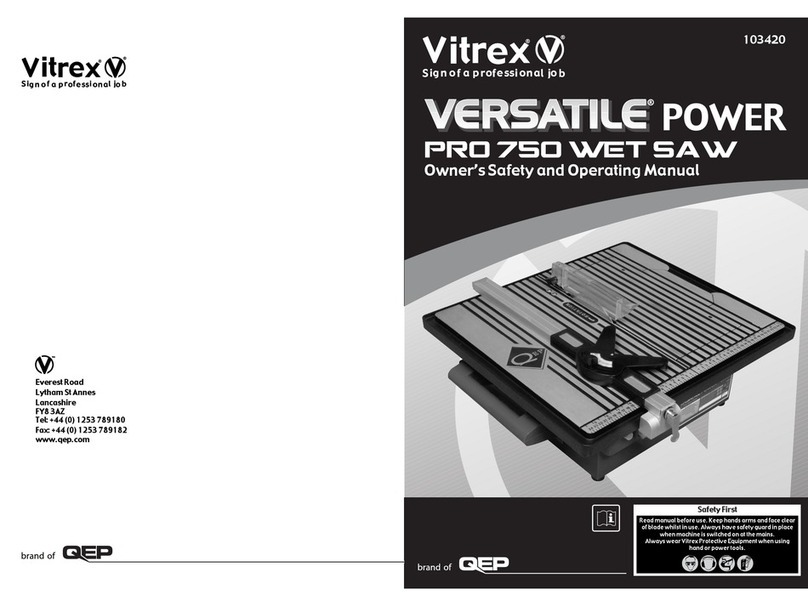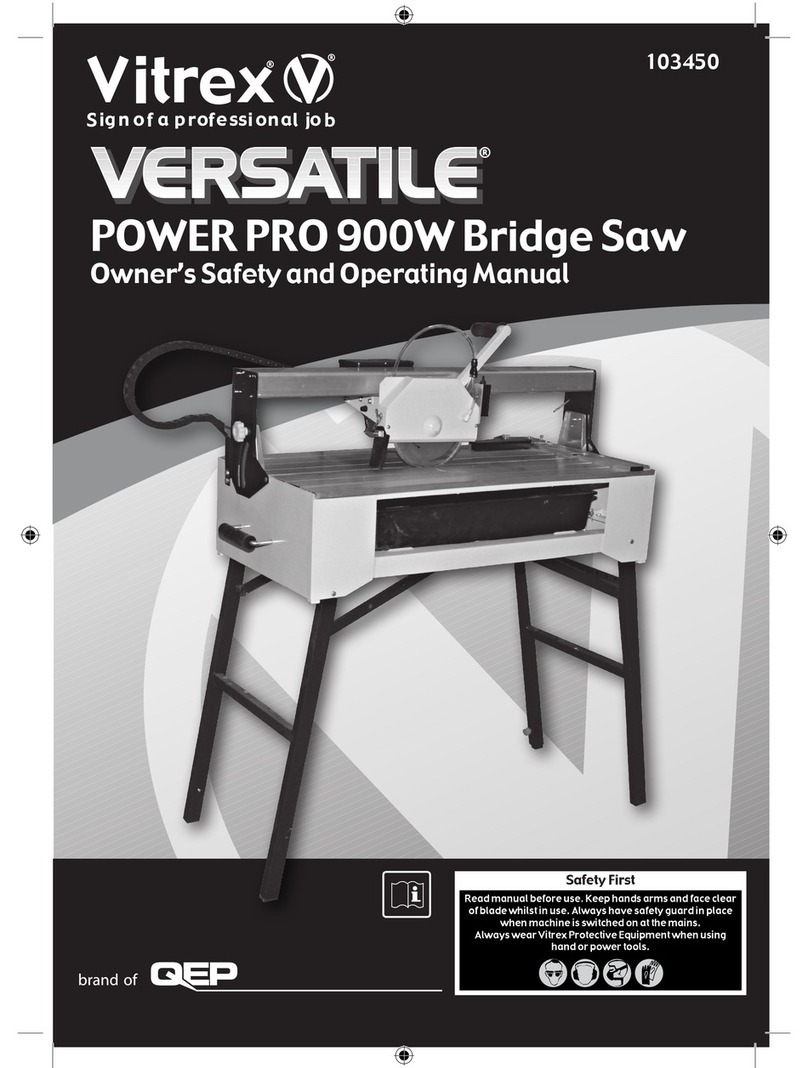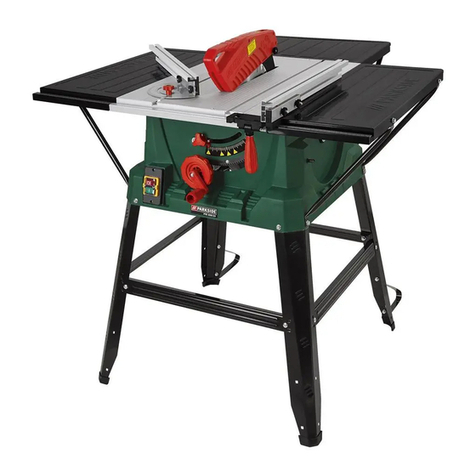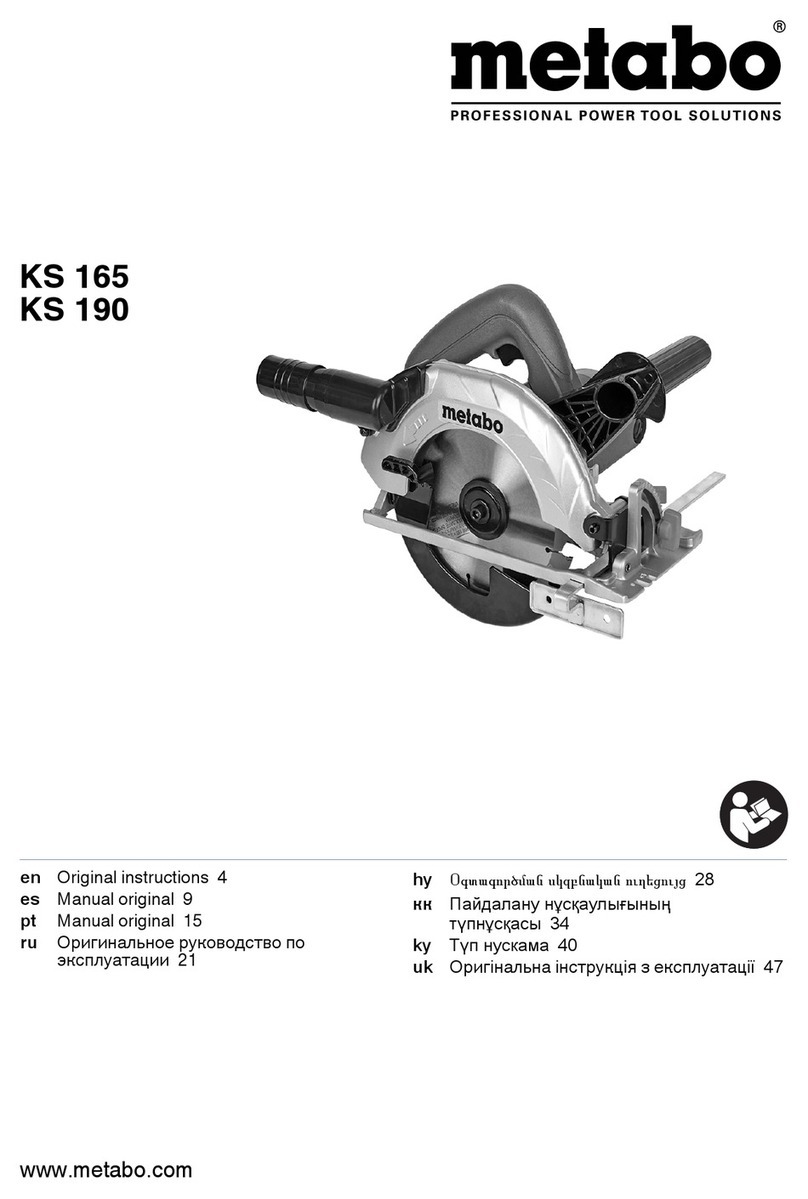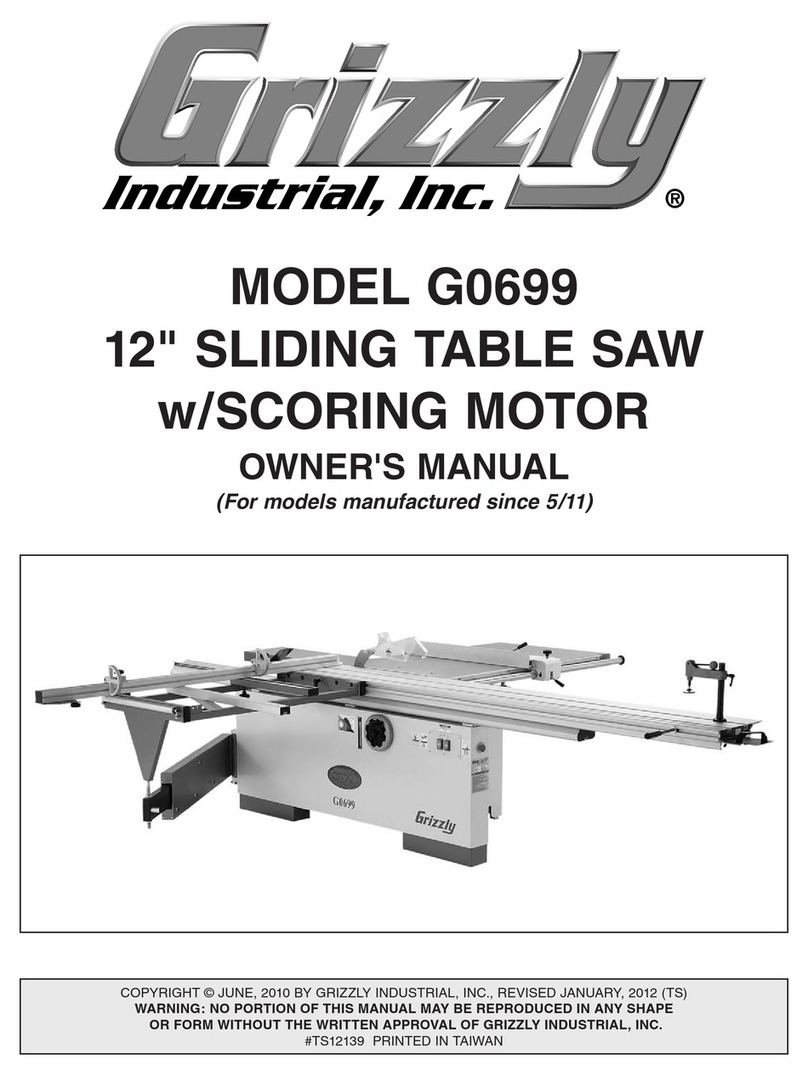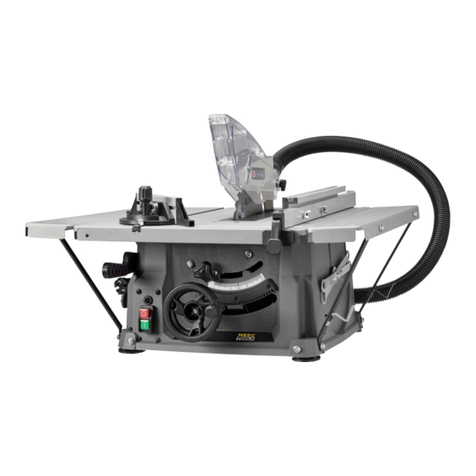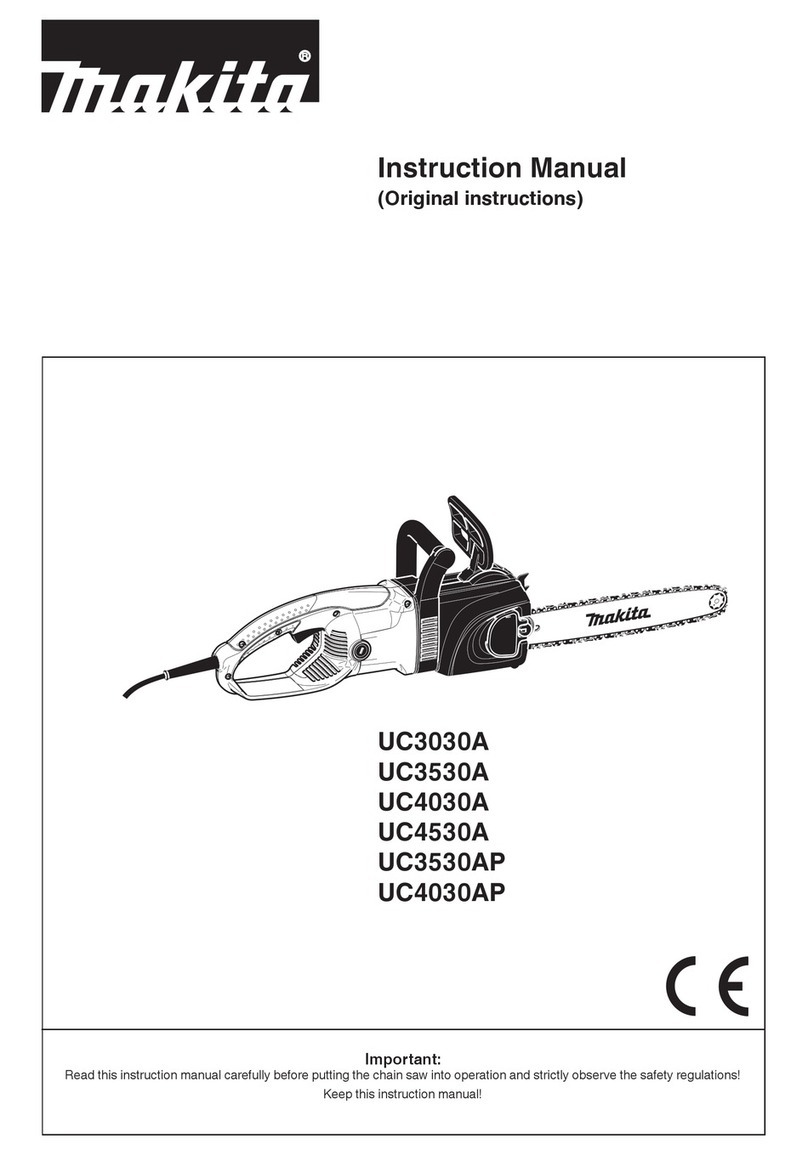Vitrex Powercut 800 User manual

Powercut 800
Bridge Saw
Safety First
Read manual before use.
Keep hands arms and face
clear of blade while its in
use. Always have safety
guard in place when machine
is switched on at the
mains. Always wear Vitrex
protective equipment when
using hand or power tools.

CONTENTS
SPECIFICATIONS ...........................................................1
SAFETY .................................................................1–2
SPECIFIC SAFETY RULES .....................................................2
SPECIAL SAFETY INSTRUCTIONS BEFORE USING MACHINE .....................2-3
ASSEMBLY ..............................................................3–4
OPERATING .............................................................4–5
MAINTENANCE...........................................................5–6
TROUBLE SHOOTING........................................................6
ACCESSORIES .............................................................6
02
CONSUMER ADVICE
• Do not dispose of
electrical products
with your normal
household waste
• Always use recycling
facilities whenever
possible
• Additional recycling
information can be
found through your local
Authority or Retailer.
• For further information
or advice, please call the
Technical Helpline on
01253 789180.
This machine has been
designed to be fully
recycled without any risk
of pollution according to
the European Directive
2002/95/EC RoHS
(Reduction of Hazardous
Substances) / WEEE
(Waste from Electrical
and Electronic Equipment).
WARNING
1. Always wear safety goggles when cutting.
2. Use splash hood for every operation for which
it can be used.
3. Disconnect saw before cleaning or changing blade.
4. Do not use any cutting blade with openings
and grooves. Use only continuous rim blades.
5. Replace damaged blade before operating.
6. Do not expose to rain or use in damp locations.
Powercut 800 Bridge Saw
Q.E.P. Co UK Ltd.
Everest Road, Lytham St Annes
Lancashire FY8 3AH
Tel +44 (0) 1253 789180
Fax +44 (0) 1253 78918

– 1 –
03
Please read this manual carefully prior to
operating and keep this manual in a safe place
for future reference.
SPECIFICATIONS
Mains voltage (Volt): 240 VAC~50Hz
Motor capacity S1: 800W
Insulation class: B
House protection class: IP54
No load speed (rpm): 2900
Max cut depth 90°/45°: 35/35mm
Max cut length: 720mm
Blade size: 200 x 22.23mm
(bore)
Table size: 1010 x 402mm
Extension: 230 x 150mm
Net weight: 31kg
SAFETY
The Powercut 800 Bridge Saw is designed for
the cutting of small and moderate size ceramic
tiles, marble and granite. This bridge saw has the
ability to cut materials at 45–90 degree angles.
GENERAL SAFETY RULES
Read these instructions carefully and keep for
future reference.
CAUTION! — To reduce the risk of accident,
electrical shock or bodily injury when using
power tools, it is recommended to always
observe basic safety precautions, including
the following:
Keep work area clear
• Cluttered areas and benches invite injuries.
Consider work area environment
• Do not expose tools to rain.
• Do not use tools in damp or wet locations.
• Keep work area well lit.
• Do not use tools in the presence
of ammable liquids or gases.
Guard against electric shock
• Avoid body contact with earthed or grounded
surfaces (e.g. pipes, radiators, ranges,
refrigerators).
• Disconnect tools from the mains when not in
use, and when changing accessories such
as blades.
• Ensure switch is in “off” position when
plugging in.
• When the tool is used outdoors, use only
extension cords intended for outdoor use and
so marked.
Keep other persons away
• Do not let people, especially children, not
involved in the work touch the tool or the
extension cord and keep them away from the
work area.
Store idle tools
• When not in use tools should be stored in a
dry locked-up place, out of reach of children.
Do not force the tool
• It will do the job better and safer at the rate
for which it was intended.
Use the right tool
• Do not force small tools to do the job of a
heavy duty tool.
• Do not use tools for purposes not intended,
for example do not use circular saws to cut
tree limbs.
Dress properly
• Do not wear loose clothing or jewellery;
they can be caught in moving parts.
• Non-skid footwear is recommended when
working as operation creates dust.
• Wear protective hair covering to contain
long hair.
Use protective equipment
• Use safety glasses.
• Use face or dust mask if working operations
create dust.
Do not abuse the cord
• Never yank the cord to disconnect it from the
socket. Keep the cord away from heat, oil and
sharp edges.
Do not overreach
• Keep proper footing and balance at all times.
Maintain tools with care
• Inspect tool cords periodically and if damaged
have them repaired by an authorized service
facility.
• Inspect extension cords periodically and
replace if damaged.
• Keep handles dry, clean and free from oil
and grease.
Stay alert
• Watch what you are doing, use common
sense and do not operate the tool when you
are tired.
Check damaged parts
• Check for alignment of moving parts,
binding of moving parts, breakage of parts,
mounting and any other conditions that may
affect its operation.
• Do not use the tool if the switch does not turn
it on and off.

– 2 –
Warning
• The use of any accessory or attachment other
than one recommended in this instruction
manual may present a risk of personal injury.
• This electric tool complies with all relevant
safety rules.
TRANSPORTATION
• Before transporting the bridge saw, lock the
cutting unit at the middle of rail by engaging the
locking system.
• Two people are required to move the bridge
saw. The leg or the machine frame can be used
to lift the machine off the ground for moving.
SPECIFIC SAFETY RULES
• Ensure that the directional arrow marked on the
blade corresponds with the rotational direction
of the motor.
• With the machine disconnected from the power
supply, rotate the blade by hand to ensure it is
free from obstruction.
• Always keep the blade-securing arbor and
collars clean.
• Ensure that the blade-securing bolt is securely
tightened.
• Never try to cut freehand. Always ensure that
the tile to be cut is pressed rmly against the
rip fence.
• Ensure that the work piece that will be cut off
has sufcient room to move sideways. Failure
to do so may result in the off-cut binding
against the blade.
• Never cut more than one tile at a time.
• Never cut pieces too small to be held securely
against the rip fence without leaving enough
space for the hand to be a safe distance from
the blade.
• Ensure that the table & surrounding area are
clear with the exception of the tile to be cut.
• Before cutting a tile piece, let the diamond
blade run freely for a few seconds. If it makes
an unfamiliar sound or vibrates excessively,
switch it off immediately and disconnect from
the power supply.
• Let the blade reach full speed before beginning
to cut.
• Let the blade come to a complete stop before
removing any jammed or cut off material from
around the blade area.
• Never allow the blade to run dry. Failure to keep
the water tray topped up will result in possible
over-heating of the diamond blade.
• Do not expose to rain or moisture.
• Wear suitable protective equipment.
• Adopt a working position to the left of the
diamond blade.
• Ensure that cut off tile pieces are not caught by
the blade and sent ying.
• Never remove loose splinters, chips or small
pieces while the diamond blade is moving.
• Before repairing faults or removing jammed tile,
always switch the bridge saw off and pull out
the mains plug.
• Before switching on, check that all spanners
and setting tools have been removed.
• When leaving the workplace, switch off the
motor and disconnect from the mains.
• The manufacturer’s safety, working and
maintenance instructions and the dimensions
stated in the Technical Information must be
adhered to.
• The relevant regulations for the prevention
of accidents and other generally recognized
safety regulations must be followed.
Caution!
• Switch off bridge saw immediately and
disconnect from the mains if;
• the power feed lead and switch are damaged
• the motor is overheating
• smoke is emitted or there is a smell of charred
insulating material.
• Use only a diamond blade for which the
maximum possible speed is not less than the
maximum spindle speed of the bridge saw and
the material to be cut.
• Fill the cooling tank 3/4 full of water. It is quite
normal for the equipment to cause splattering
during use.
SPECIAL SAFETY
Check the following points:
1. Does the voltage of the motor correspond to
the mains voltage.
2. A grounded mains connection (wall socket)
needs to be used.
3. Are the mains lead and the mains plug in
a good condition without any loose ends
or damage.
• Avoid using long extension cables.
• Always place the cutting machine on
a at surface to prevent instability.
While using the machine:
1. Never use-cracked diamond saw blade,
replace them.
04

– 3 –
2. Be sure that the switch is in the OFF-position
before connecting the machine to the
mains voltage.
3. Always keep away the mains lead from moving
parts of the machine.
4. Do not apply side-pressure to the saw blade. It
can break the blade and cause injury.
5. Remove the plug out of the wall socket before
you open the machine.
IMMEDIATELY SWITCH OFF THE
MACHINE IN CASE OF:
• Excessive sparking of the brushes.
• Malfunction of the mains plug, socket or
damaged cables.
• Broken switch.
• Smoke or smell caused by scorched insulation.
ASSEMBLY
Read the manual carefully before installation
1. Clean the working area, open the package and
remove all packing materials, you will nd the
folded machine. (see FIGURE 1)
FIGURE 1
2. Lay the machine on its side on the ground,
assemble one leg by screwing it into the nut
welded under the main frame (see FIGURE 2),
make sure it is tightened by means of tools (see
FIGURE 3 and FIGURE4).
Following the same procedure to x other 3 legs,
and then stand the saw upright.
FIGURE 2
FIGURE 3
FIGURE 4
To stabilize and level the saw, adjust the leveling
“set screw” located on the bottom of one leg
(see FIGURE 5).
FIGURE 5
3. To assemble the handle, position the handle
against the blade guard and secure it using the
attached 3 screws.
4. The cutting unit is locked in the middle of slide
rail during shipment. Before using the saw, pull
the lock knob out of its slot and rotate and put it
into the upright slot (see FIGURE 6).
lock knob
FIGURE 6
05

– 4 –
Note: When not in use, please always make sure
the cutting unit is locked at the middle of the
slide rail to prevent it from rolling back and forth
along the bridge. Move the cutting unit until the
arrow is aimed at the marked lock position and
put the knob into the locked position. Continue
moving the cutting unit along the slide rail until
fully locked.
OPERATING
Filling The Water Tray And Draining
1. Fill the tray with water through the cutting slot.
Don’t add chemicals or detergents to the water.
2. Be sure that the water level is always
between the MAX and MIN level, so that the
saw blade turns through appropriate water.
This is necessary to cool the saw blade in a
correct way.
3. If the machine is not used, water should be
drained. Remove the plug from the bottom of tray
the water will ow out or you can take out the
tray and pour the water out.
Starting And Stopping
1. Insert the plug into a socket with a safety
contact. This must be protected with a fuse
e.g. in the terminal box. If an extension cable is
required, please note that with a cable length of
up to 20m cable with a cross-section of 1.5mm²
must be used.
2. To start the saw, press the green button
marked “I”.
3. To stop the saw, press the red button “O” (see
FIGURE 7).
FIGURE 7
Overload Protection: the motor is equipped with
a Circuit Breaker at the side face of the switch
box. If the motor is over loaded, gets too hot or
the current gets very big, the circuit breaker will
act automatically and power down the machine.
If this occurs, please wait a few minutes until the
motor has cooled down and then press the reset
button (beside the On-/Off-Switch) and the bridge
saw can be restarted.
Making A Straight Cut
1. Loosen the knob of the angle cutting guide
and position the tile on the cutting table against
the fence with the zero aligned with the notch,
so that it is in a straight line. This indicates “no
angle”, or a straight cut. The angle cutting guide
will be at a 90º angle to the fence. Tighten knob to
keep guide in position (see FIGURE 8).
FIGURE 8
2. Slide the angle guide against the tile and lock
the gauge by turning the knob.
3. Keep the tile rmly against the fence and
the angle cutting guide, slowly and smoothly
pull blade assembly handle towards you to
begin cutting. DO NOT force the motor to cut
too quickly.
NOTE: Pay attention to the width of the work
piece. If the width on “a” is more than 250mm
(see FIGURE 9) and the width on “b” is more than
550mm (see FIGURE 10), please assemble the
extension table to support the work piece.
FIGURE 9
FIGURE 10
06

– 5 –
Making a Mitre Cut
1. Loosen the knob and position the rip/miter
guide so that the correct angle you want, 0º to
45º, is lined up with the notch. Tighten knob at
that position.
2. Align the tile with rip/miter guide and hold
rmly against guide. As in above straight cut,
slowly and smoothly pull blade assembly handle
towards you to begin cutting. (see FIGURE 11)
FIGURE 11
Making A Bevel Cut
1. Loosen the knobs located on each rail end of
the bridge saw (see FIGURE 12).
2. Tilt the bridge to the desired bevel angle 0º to
45º. Be sure to line up the bevel angle degree
markings on each of the end rail stand. The
degree of bevel cut can also be seen through the
transparent window above end rail stand.
3. Tighten the knobs and follow directions above
to make cut.
FIGURE 12
Installing/Replacing the Blade
WARNING! — Disconnect the power supply
before installing or making adjustments to
the blade.
Only use a diamond saw blade with a diameter
of 200mm for Powercut 800 Bridge Saw. The
bore of the blade must be 22.23mm.
1. First, to disconnect the water supply, press
the blue ring and pull out the water supply tube
from the inlet connection on the blade guard (see
FIGURE 13).
FIGURE 13
2. Then, remove the blade guard by removing
the two securing screws (see FIGURE 14 and
FIGURE 15).
FIGURE 14
FIGURE 15
3. Ensure that the shaft and anges are clean
and re-t the blade in the opposite manner.
Directional arrows on blade MUST line up with
directional arrow on blade guard, so that material
to be cut is against the direction of rotation.
4. Replace the ange back, and adjust the blade
to get the best balance of blade.
5. Fix the lock nut tightly.
MAINTENANCE
CAUTION! — While maintaining and cleaning
the machine pull the plug from the mains socket.
• Never use water or other aggressive liquids
while cleaning electrical parts of the machine.
07

– 6 –
• Periodic maintenance of the bridge saw will
prevent unnecessary problems. Keep the
ventilation slots of the bridge saw clean to
prevent overheating of the motor.
• Dry the bridge saw as much as possible
after using.
Pump Maintenance
Warning! — Always disconnect from electrical
outlet before handling the pump.
• Do not let the pump run dry.
• Do not lift the pump by the power cord.
• Do not pump heated liquids.
• Operate in freshwater only.
• Operate pump completely submerged for
proper cooling.
intake
cover
flow
regulator
impeller
cover
impeller
motor head
outlet
FIGURE 16
A clogged or dirty intake cover will greatly
reduce performance. If the pump is used in
dirty water, raise it slightly to reduce the amount
of debris contacting the intake. If
less ow is desired, adjust the ow regulator
on the front of the pump.
Do not let the pump run when not submerged in
water. Doing so may damage the pump. Always
submerge the pump rst, and then plug in the
electrical outlet. If the pump does not function
straight away, switching the power on and off
several times will normally correct this.
To clean the pump, remove the intake cover
and the impeller. Use a small brush or stream of
water to remove any debris.
TROUBLE SHOOTING
If The Pump Fails To Operate,
Check The Following:
• Check the circuit breaker and try another power
source to ensure the pump is getting electrical
power. NOTE: Always disconnect from
electrical outlet before handling the pump.
• Check the pump discharge and tubing for kinks
and obstructions. Algae build up can be ushed
out with a jet of water.
• Check the intake cover to ensure it is not
clogged with debris.
• Remove the intake cover to access the
impeller area. Turn the impeller to ensure it is
not broken or jammed.
• Monthly maintenance will add to your
pump’s life.
NOTE: Ensure that the electrical cord loops
below the electrical outlet to form a “Drip
Loop.” This will prevent water from running
down the cord into the electrical outlet.
Replacing The Pump
If the pump still does not work, you have to
replace pump with a new one. Only use the pump
recommended by the manufacturer of the bridge
saw. Call the Technical Helpline on 01253 789180
or return to location of purchase.
The changing procedures are as follows:
1. Loosen the bolt of the pump connecting box
located on one end of main frame and remove
the cover.
2. Loosen the bolt of the pump cable lock and
take the pump plug out of connecting box (see
FIGURE 17).
FIGURE 16
3. Take out the pump and replace a new one,
install the new pump by reversing the above
procedures.
ACCESSORIES
• 45-degree angle guide
• Parallel rip fence
• Hexagonal blade wrench
• Motor shaft holding wrench
08
Table of contents
Other Vitrex Saw manuals
Popular Saw manuals by other brands

CRAIN
CRAIN 820/820V operating instructions

Powermatic
Powermatic 66 operating instructions
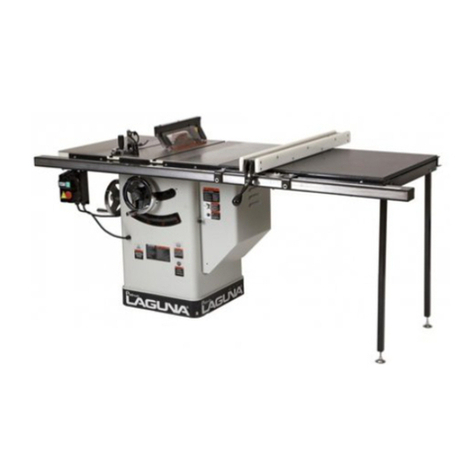
Laguna Tools
Laguna Tools HW110LS-30 owner's manual

MK Diamond Products
MK Diamond Products MK-212 Series Owner's manual & operating instructions
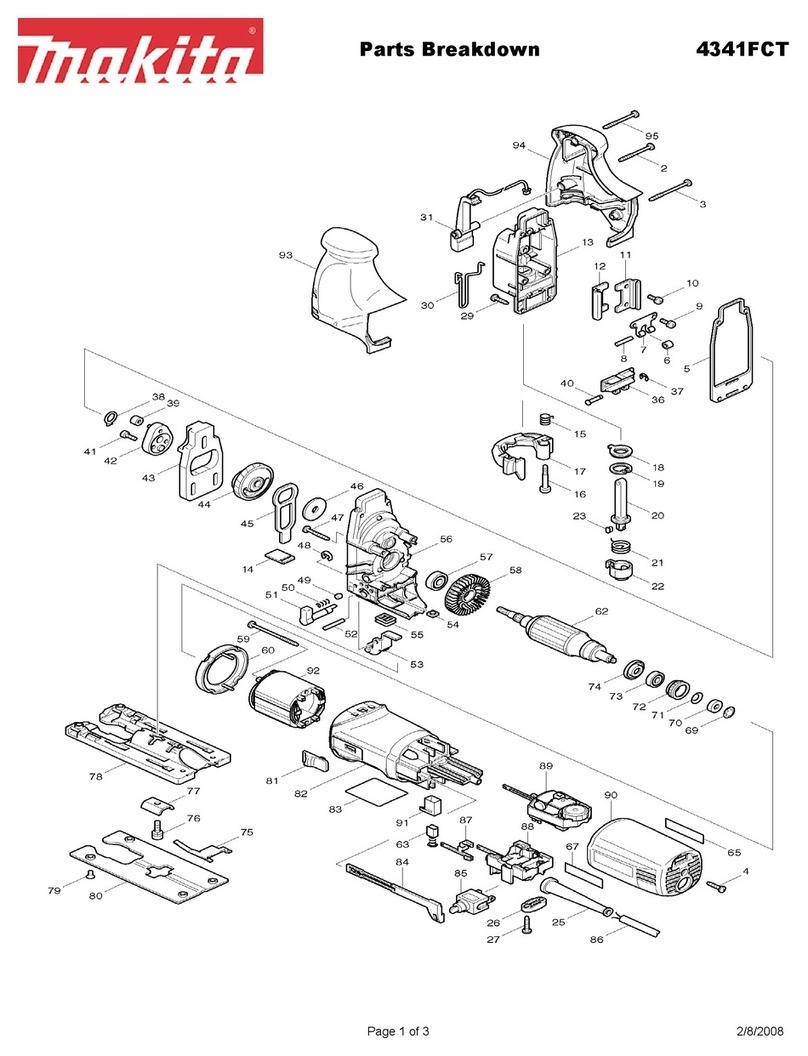
Makita
Makita 4341FCT Parts Breakdown
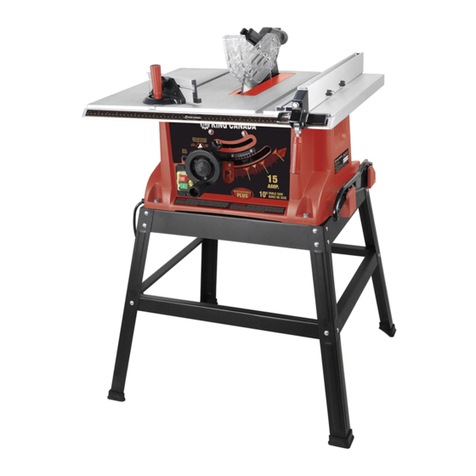
King Canada
King Canada KC-5006R instruction manual
